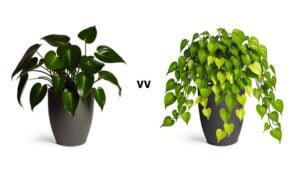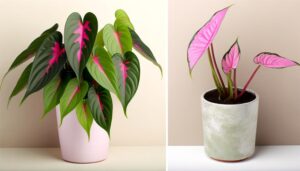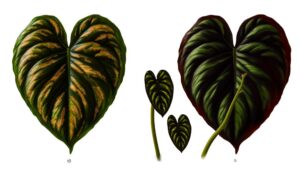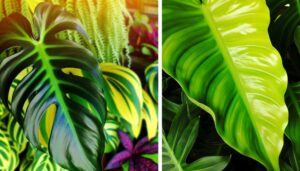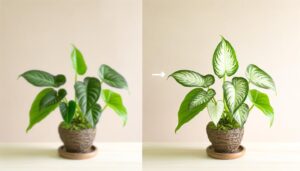Philodendron Hope Vs Xanadu: Which to Choose?
Philodendron bipinnatifidum (Philodendron Hope) and Philodendron xanadu are distinct members of the Araceae family. Philodendron Hope features large, deeply lobed, leathery leaves up to 1.5 meters, forming an arborescent structure, and is native to subtropical South America.
Philodendron xanadu exhibits compact, oval-shaped glossy leaves up to 40 centimeters, with a bushy, horizontal growth habit originating from tropical Brazil. Both species thrive in bright, indirect sunlight and prefer well-draining soil with a pH of 5.5-6.5.
Philodendron Hope is ideal for spacious interiors, while Philodendron xanadu suits smaller landscapes and container gardening. For further fascinating details, continue exploring.
Comparison of Philodendron Hope and Philodendron Xanadu
| Feature | Philodendron Hope | Philodendron Xanadu |
|---|---|---|
| Common Names | Tree Philodendron, Lacy Tree Philodendron | Xanadu Philodendron, Winterbourn |
| Scientific Name | Philodendron bipinnatifidum | Philodendron xanadu |
| Family | Araceae | Araceae |
| Origin | Tropical regions of South America | Brazil |
| Leaf Shape | Large, deeply lobed leaves | Smaller, deeply lobed leaves |
| Leaf Size | Can grow up to 4 feet long | Typically up to 18 inches long |
| Growth Habit | Upright, self-supporting | Upright, clumping |
| Mature Height | Up to 15 feet indoors, larger outdoors | Up to 3-5 feet indoors |
| Mature Width | Spreads widely with age | Forms a dense, bushy clump |
| Light Requirements | Bright, indirect light | Bright, indirect light |
| Watering Needs | Moderate; keep soil consistently moist | Moderate; allow top inch of soil to dry out |
| Humidity Requirements | High | Moderate to high |
| Temperature Tolerance | Prefers 65-80°F (18-27°C) | Prefers 65-80°F (18-27°C) |
| Soil Preference | Well-draining, rich soil | Well-draining, rich soil |
| Fertilization | Monthly during growing season | Monthly during growing season |
| Toxicity | Toxic to pets and humans | Toxic to pets and humans |
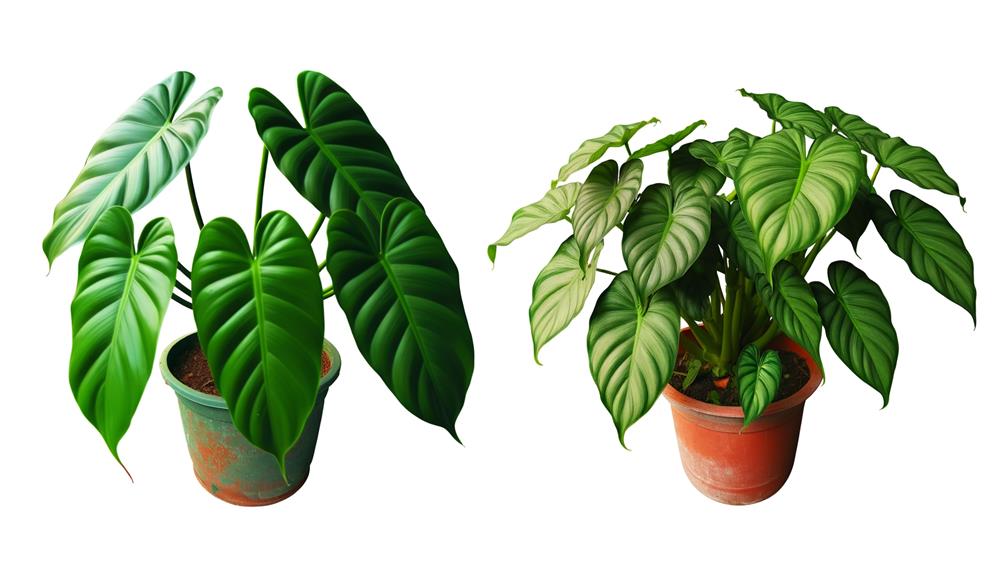
Key Takeaways
- Space: Philodendron Hope can grow significantly larger, making it ideal for spacious areas, while Philodendron Xanadu is more compact and suitable for smaller spaces.
- Leaf Size and Shape: If you prefer larger, more dramatic leaves, Philodendron Hope is the better choice. For a more refined look with smaller leaves, opt for Philodendron Xanadu.
- Maintenance: Both plants have similar care requirements, but Xanadu’s more compact growth habit may make it easier to manage in indoor settings.
- Humidity: Philodendron Hope thrives in higher humidity, while Xanadu can tolerate a wider range of humidity levels.
Botanical Overview
Philodendron Hope (Philodendron bipinnatifidum) and Philodendron Xanadu (Philodendron xanadu) are distinct species within the Araceae family, each displaying unique morphological characteristics and growth patterns.
Philodendron bipinnatifidum is characterized by its large, deeply lobed leaves, which can reach up to 1.5 meters in length. The plant typically develops a self-supporting, tree-like structure with a robust stem.
In contrast, Philodendron xanadu features smaller, more compact leaves with a wavy margin, growing to an average size of 40 centimeters. This species forms a dense, bushy growth habit, spreading horizontally rather than vertically.
Both species possess aerial roots that aid in stability and nutrient absorption but differ significantly in overall size and leaf morphology, reflecting their adaptation to distinct ecological niches.
Origin and Habitat
Understanding the distinct morphological traits of Philodendron bipinnatifidum and Philodendron xanadu necessitates an examination of their origin and natural habitat, as these factors play a pivotal role in shaping their growth forms and ecological adaptations.
Philodendron bipinnatifidum, commonly known as Philodendron Hope, is native to the subtropical regions of South America, particularly Brazil, Bolivia, Argentina, and Paraguay. In contrast, Philodendron xanadu originated in the tropical climates of Brazil but has been widely cultivated for ornamental purposes.
The environmental conditions of their native habitats, such as humidity, soil composition, and light availability, contribute significantly to their physiological characteristics.
| Feature | Philodendron bipinnatifidum | Philodendron xanadu |
|---|---|---|
| Native Region | Subtropical South America | Tropical Brazil |
| Primary Countries | Brazil, Bolivia, Argentina, Paraguay | Brazil |
| Habitat Type | Subtropical forests | Tropical forests |
| Soil Composition | Well-drained, rich organic matter | Well-drained, slightly acidic |
| Light Availability | Partial to full shade | Bright indirect light |
Leaf Shape and Texture
Philodendron bipinnatifidum, commonly referred to as Philodendron Hope, exhibits deeply lobed, pinnate leaves with a leathery texture.
Philodendron xanadu presents more compact, oval-shaped leaves with pronounced lobes and a glossy surface.
The venation patterns in P. bipinnatifidum are more prominent and give the leaves a textured appearance, whereas P. xanadu features smoother leaf veins that contribute to its polished look.
These morphological differences in leaf shape and texture play a significant role in distinguishing the two species.
Distinctive Leaf Patterns
The leaf morphology of Philodendron bipinnatifidum (Hope) and Philodendron xanadu exhibits distinct variations, characterized by the deeply lobed, pinnatifid leaves of Hope and the more compact, undulate margins of Xanadu.
Philodendron bipinnatifidum’s leaves are large, deeply dissected, and exhibit a pinnatifid structure with extended lobes that provide a dramatic, architectural appearance.
In contrast, Philodendron xanadu presents leaves that are smaller, with undulate, wavy margins, and a more uniform, less dissected pattern compared to Hope.
The texture of Hope’s leaves tends to be leathery and robust, while Xanadu’s leaves are smoother and more delicate.
These morphological differences play a key role in differentiating the two species and contribute to their distinct aesthetic and functional applications in horticulture.
Vein and Surface Differences
In addition to their distinctive leaf patterns, the vein and surface differences between Philodendron bipinnatifidum (Hope) and Philodendron xanadu further highlight their unique characteristics.
Hope showcases prominent, deeply indented veins and a coarser texture, while Xanadu features less pronounced venation and smoother, glossier surfaces.
Philodendron bipinnatifidum’s leaves exhibit a rugged, almost leathery texture, enhancing its hardy appearance, and its venation is markedly recessed, providing a sculpted look.
Conversely, Philodendron xanadu’s leaves are characterized by a more delicate, satin-like finish, and its venation is subtler, lending a more refined and elegant aesthetic.
These attributes not only distinguish them visually but also influence their tactile experience, making each species uniquely appealing to plant enthusiasts.
Growth Habit
The growth habit of Philodendron bipinnatifidum (commonly known as Philodendron Hope) and Philodendron xanadu exhibits notable differences in leaf structure, stem growth patterns, and overall size and spread.
Philodendron Hope typically develops large, deeply lobed leaves and a more upright, tree-like form, whereas Philodendron xanadu is characterized by smaller, less lobed leaves and a compact, clumping growth habit.
Additionally, the internodal length and stem thickness vary between the two species, influencing their spatial requirements and visual aesthetics.
Stem Growth Patterns
Exhibiting distinct growth habits, Philodendron bipinnatifidum and Philodendron xanadu demonstrate varied stem development. P. bipinnatifidum often forms a robust, semi-woody trunk, while P. xanadu has a more clumping, basal rosette structure.
- bipinnatifidum, also known as Philodendron selloum, typically exhibits an erect, tree-like growth pattern. It is characterized by elongated, sturdy stems that support large, pinnately lobed leaves.
On the other hand, P. xanadu maintains a more compact form, with its stems emerging from a central base, creating a bushy, dense appearance. The basal rosette growth of P. xanadu results in shorter internodes, contributing to its more constrained and ornamental structure. This makes it a popular choice for indoor cultivation.
Size and Spread
Evidently, P. bipinnatifidum and P. xanadu exhibit distinct size and spread characteristics, with P. bipinnatifidum often reaching heights of up to 15 feet while P. xanadu typically remains more compact, seldom exceeding 4 feet in both height and width. This disparity in growth habit can be attributed to their differing physiological and ecological requirements.
Bipinnatifidum, also known as the ‘Tree Philodendron,’ develops a robust, arborescent structure, necessitating ample vertical and horizontal space. Conversely, P. xanadu, or ‘Winterbourn,’ is characterized by its clumping habit, forming dense, manageable mounds.
Key distinctions include:
- Maximum height of P. bipinnatifidum: 15 feet
- Maximum height and width of P. xanadu: 4 feet
- Growth habit of P. bipinnatifidum: Arborescent
- Growth habit of P. xanadu: Clumping
Light Requirements
Ideal light conditions for Philodendron bipinnatifidum and Philodendron xanadu require bright, indirect sunlight to flourish while minimizing potential leaf scorch. For the best photosynthetic efficiency, these species should be placed in locations where they receive filtered light, such as near east or north-facing windows.
Direct exposure to intense sunlight can cause photoinhibition, resulting in chlorosis and necrotic leaf margins. Conversely, insufficient light may lead to etiolation and diminished foliage vigor. Utilizing sheer curtains or positioning the plants in well-lit rooms without direct sun exposure can help maintain their vibrant green pigmentation.
Artificial grow lights emitting full-spectrum wavelengths can supplement natural light, particularly during shorter daylight periods, ensuring consistent growth and robust morphological development.
Watering Needs
When considering the watering needs of Philodendron bipinnatifidum (Philodendron Hope) and Philodendron xanadu (Xanadu), it is crucial to assess their frequency of watering, ideal soil moisture levels, and adjustments required for seasonal changes.
Both species thrive in well-draining substrates but have differing tolerances to drought and water-logging. Monitoring soil moisture through consistent checks will guarantee proper hydration and prevent root rot, particularly during periods of changing environmental conditions.
Frequency of Watering
Proper hydration is crucial for both Philodendron bipinnatifidum ‘Hope’ and Philodendron xanadu, though their watering needs can differ based on environmental conditions and growth stages. Generally, these species require consistent moisture but must not be waterlogged.
Key considerations include:
- Seasonality: Watering frequency should be reduced in winter when plant metabolic activities slow down.
- Pot Size and Type: Larger pots retain moisture longer, necessitating less frequent watering compared to smaller pots.
- Ambient Humidity: Higher humidity levels reduce transpiration rates, thereby decreasing the need for frequent watering.
- Growth Stage: Actively growing plants in the vegetative phase require more frequent watering compared to those in dormant stages.
Adhering to these factors ensures optimal hydration, promoting robust growth and vitality.
Soil Moisture Levels
Understanding the specific soil moisture levels required for Philodendron bipinnatifidum ‘Hope’ and Philodendron xanadu is crucial in meeting their watering needs effectively. Philodendron bipinnatifidum ‘Hope’ thrives in soil that remains consistently moist but not waterlogged; ideal conditions are achieved through a well-draining mix rich in organic matter.
Conversely, Philodendron xanadu prefers slightly drier conditions; its roots are susceptible to rot in overly saturated soils. Maintenance of moderate moisture, allowing the top inch of soil to dry between waterings, is recommended.
Both species benefit from substrates that provide aeration and drainage, such as a combination of peat moss, perlite, and pine bark. Monitoring soil moisture with a hygrometer ensures precise management, thereby promoting healthy root development and overall plant vigor.
Seasonal Watering Changes
Seasonal variations greatly impact the watering schedule for Philodendron bipinnatifidum ‘Hope’ and Philodendron xanadu, requiring changes to maintain ideal soil moisture levels throughout the year.
During the growing season, typically spring and summer, both species necessitate increased hydration due to higher rates of transpiration and metabolic activity.
Conversely, reduced watering is essential during fall and winter to prevent root rot and over-saturation.
Key watering adjustments include:
- Spring/Summer: Water frequently to maintain consistent moisture without waterlogging the soil.
- Fall/Winter: Decrease watering frequency, allowing the soil to dry partially between waterings.
- Humidity: Employ misting or humidifiers during dry seasons to supplement ambient moisture.
- Soil Drainage: Ensure well-draining soil to avoid water retention issues, optimal throughout all seasons.
These practices guarantee best growth and health for both Philodendron varieties.
Soil Preferences
Both Philodendron bipinnatifidum ‘Hope’ and Philodendron xanadu thrive in well-draining, aerated soil that maintains consistent moisture without becoming waterlogged. Ideal soil composition includes a blend of peat, perlite, and pine bark, which promotes sufficient aeration and moisture retention while preventing root rot.
Utilizing a pH range between 5.5 and 6.5 is beneficial, as it enhances nutrient availability. Adding organic matter, such as compost or aged manure, improves the soil structure and provides necessary nutrients. Avoid dense clay soils, which can hinder drainage and airflow, potentially causing health issues for the plant.
For container growth, choosing a premium potting mix specifically designed for aroids can further enhance the philodendrons’ growth and vitality.
Temperature and Humidity
Philodendron bipinnatifidum ‘Hope’ and Philodendron xanadu thrive in environments where temperatures range between 65°F to 80°F (18°C to 27°C) and humidity levels are consistently maintained above 60%.
These conditions are vital for best growth and overall health. Maintaining these parameters promotes vigorous foliage and reduces stress factors that could hinder development.
Key factors to keep in mind include:
- Relative Humidity: Keeping relative humidity above 60% helps prevent desiccation and supports cellular functions.
- Temperature Stability: Avoiding sudden temperature fluctuations minimizes plant shock and promotes steady growth.
- Indoor Placement: Positioning plants away from direct drafts or heating sources guarantees a stable microclimate.
- Humidity Control: Using humidifiers or pebble trays can help maintain appropriate humidity levels in drier environments.
Understanding these conditions is crucial for cultivating healthy, robust specimens.
Common Pests and Diseases
Aphids (Aphidoidea), mealybugs (Pseudococcidae), and spider mites (Tetranychidae) are among the most common pests that can afflict Philodendron bipinnatifidum ‘Hope’ and Philodendron xanadu, often leading to significant damage if not promptly managed. Aphids feed on sap, causing leaf curling and yellowing.
Mealybugs, identifiable by their cotton-like appearance, secrete honeydew that fosters sooty mold. Spider mites, virtually microscopic, induce stippling and bronzing on leaves through their piercing-sucking mouthparts.
These infestations can be mitigated by regular inspections and employing insecticidal soaps or neem oil. Additionally, fungal diseases such as root rot (caused by Pythium spp.) and bacterial leaf spots (Xanthomonas spp.) are prevalent, necessitating well-drained soil and proper sanitation to prevent pathogenic outbreaks.
Propagation Methods
Maintaining the health of Philodendron bipinnatifidum ‘Hope’ and Philodendron xanadu involves pest management and effective propagation methods to guarantee robust growth and sustainability. Both species can be propagated through vegetative means, ensuring genetic consistency and vigor.
Key methods for propagation include:
- Stem Cuttings: Utilize a sharp, sterilized knife to cut below a node, then root in water or soil.
- Division: Carefully separate the root ball, ensuring each division has an adequate root system.
- Air Layering: Encourage root formation on a stem while it is still attached to the parent plant by wrapping it in moist sphagnum moss and plastic.
- Leaf Cuttings: Though less common, some success can be achieved by rooting leaves with a small piece of stem attached.
These methods promote healthy, robust plants.
Ideal Uses
The versatility of Philodendron bipinnatifidum ‘Hope’ and Philodendron xanadu makes them exemplary choices for a variety of interior and exterior landscaping applications.
Philodendron bipinnatifidum ‘Hope’, with its larger, deeply lobed leaves, is ideal for creating focal points in spacious interiors or shaded outdoor areas, contributing to a lush, tropical ambiance.
Conversely, Philodendron xanadu, characterized by its more compact growth habit and smaller, finely dissected leaves, is suitable for use in container gardening, office spaces, and smaller residential landscapes.
Both species exhibit remarkable adaptability to low light conditions, enhancing their desirability for indoor environments.
Their robust growth patterns and minimal maintenance requirements make them suitable for both novice gardeners and professional horticulturists seeking to elevate aesthetic appeal.
Philodendron Bipinnatifidum vs. Xanadu
Philodendron Bipinnatifidum:
- Appearance: Known for its large, deeply lobed, and glossy green leaves that have a somewhat leathery texture. The leaves can grow very large, often up to 3 feet long.
- Growth Habit: A larger, tree-like plant that can reach heights of 4-6 feet or more. It tends to spread out, requiring more space.
- Light Requirements: Prefers bright, indirect light but can tolerate lower light conditions.
- Care: Needs well-draining soil, regular watering (allowing the top inch of soil to dry out between waterings), and moderate to high humidity.
Philodendron Xanadu:
- Appearance: Features smaller, deeply lobed, and glossy green leaves that are more compact compared to Bipinnatifidum. The leaves typically grow to about 16 inches long.
- Growth Habit: More compact and bushy, reaching about 2-4 feet in height and width, making it suitable for smaller spaces.
- Light Requirements: Thrives in bright, indirect light but can also adapt to medium light conditions.
- Care: Requires well-draining soil, regular watering (allowing the top inch of soil to dry out between waterings), and moderate humidity.
Key Differences:
- Size: Bipinnatifidum is much larger, with a more tree-like growth habit, while Xanadu is more compact and bushy.
- Leaf Size and Shape: Bipinnatifidum has larger, more dramatically lobed leaves, whereas Xanadu has smaller, more evenly lobed leaves.
- Space Requirements: Bipinnatifidum needs more space due to its size and spreading habit, whereas Xanadu is better suited for smaller spaces.
Both plants are excellent for adding a tropical feel to your home, with the choice depending on the available space and your preference for leaf size and plant height.
Conclusion
The unparalleled grandeur of Philodendron bipinnatifidum ‘Hope’ and Philodendron xanadu is evident in their distinct botanical characteristics and adaptive growth habits.
The architectural elegance of their foliage, coupled with their divergent environmental preferences, underscores their botanical magnificence.
Their resilience against pests and diseases, alongside versatile propagation methods, makes them indispensable in horticultural endeavors.
Ultimately, these botanical marvels transcend mere houseplants, becoming emblematic representations of nature’s incredible adaptability and aesthetic brilliance.

